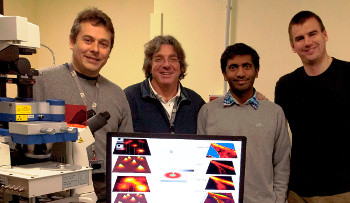JPK Instruments, a world-leading manufacturer of nanoanalytic instrumentation for research in life sciences and soft matter, reports on the research studies of the nanophysics group to couple the chemical information of STED microscopy with the high resolution spatial and force measurements provided by AFM to study biological samples in liquid.
 Dr Claudio Canale, Professor Alberto Diaspro, Jenu Chacko-Varghese and Dr Benjamin Harke - the group to have coupled STED and AFM at the Department of Nanophyiscs, IIT, Genova.
Dr Claudio Canale, Professor Alberto Diaspro, Jenu Chacko-Varghese and Dr Benjamin Harke - the group to have coupled STED and AFM at the Department of Nanophyiscs, IIT, Genova.
The Istituto Italiano di Tecnologia (IIT) was founded in 2003 in the city of Genova to promote Italy's technological development and advanced education. Professor Alberto Diaspro is the Director of the Department of Nanophysics. His research includes the design, realization and utilization of optical and biophysical instrumentation such as far-field super resolution optical microscopy and nanoscopy, conventional and confocal microscopy, two-photon fluorescence microscopy and spectroscopy architecture, and scanning probe microscopy (STM, SNOM, AFM). This last area has led to collaborations with JPK Instruments.
Dr Claudio Canale is a team leader in the group focusing on the application of scanning probe techniques in the study of bio-materials and bio-mechanisms. One of his main projects has been to couple STED (stimulated emission depletion microscopy) and atomic force microscopy (AFM). Describing this work, Dr Canale said "in our department, an entire group works on the development of optical super-resolution techniques and this has led to a STED microscope based on a conventional multi-photon platform from Nikon Instruments. Together with Dr Benjamin Harke, we had the idea to couple the capability of this instrument with those offered by an AFM. For the AFM, we chose the NanoWizard® from JPK."
There have been several iterations of the new combined set-up. This work has been reported in a paper published by the group in the journal, Optical Nanoscopy1. Now, the main goal is to characterize biological processes having simultaneous access to morphological and mechanical properties and coupling both of them with chemical recognition capability directly provided by STED with a resolution in the order of tens of nanometers. Working on model membranes, Dr Canale says "we can recognize target molecules or particular membrane components by STED and we can look at the fine structural and mechanical changes by AFM."
The choice of JPK's AFM came after experience using many different commercial AFM systems. Settling on the NanoWizard, Dr Canale comments "I found the JPK system extraordinarily comfortable for this application. I think that JPK have produced a system with a special aptitude towards biology. This approach to the development of stable systems that provide state of the art performance applications in liquid with a user-friendly approach that makes the system easily accessible not only to users with a physical background but also to biologists and biochemists. In particular, I have been impressed by the unique capability of this instrument to work in a liquid environment with both nanometric spatial and piconewton force resolution."